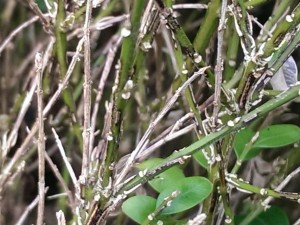25 Mar The Pause…Today; Box Blight: 4 Steps to Understanding and Managing
Buxus sempervirins’ Toxic Love Affair
I love box, sadly so do the fungal pathogens Cylindrocladium buxicola and Volutella buxi and that is one toxic love affair you can do with out! You know it’s taken hold when your fabulous clipped box loose their glamour, and start to show signs of stress, patchy brown leafless twigs, black spots and a confetti of tiny brown leaves covering the ground…not dissimilar in effect, to the morning after the most knockout party ever.
This winter I was dismayed to find, that my precious box had succumbed to the advances of these fungal pathogens; at first I thought it was burn from the local tom cat marking his territory, but alas on closer inspection the tell tell brown black spots were evident. After research, I decided to take drastic action and removed and burnt the two worst affected plants. Some remaining plants are showing blight signs. For them I am following my 4 Steps to Managing Box Blight. Read on…
Box blight is a fungus disease. The fungi cause leaves to go brown and fall, this usually starts within the middle of the plant causing the plant to die back. Young stems can also be affected showing distinct and diagnostic dark brown to black lesions along the stem to the tip. This disease will repeatedly infect plants, which can weaken the plant and lead to death. There are two fungus pathogens that cause the disease:
– Cylindrocladium buxicola
– Volutella buxi
The Fungus spores love the damp and thrive during warm humid summers, the rain splashes spores and they spread rapidly in a matter of days. Avoid cutting plants when it is wet, try to cut when you have a few days of dry weather ahead! Encourage air flow, cut out all affected growth, do not add to the compost heap, ideally burn it.
If you need to make infilling repairs to your box hedge, try tracking down more resistant varieties from reputable suppliers; quarantine before planting. If recently clipped avoid over head watering. Try to keep your box cutting equipment separate; disinfect after use. Be diligent about plant and garden hygiene. Provide good plant nutrition.
1. TREATMENT
Few fungicides can fight against box disease, but there are plenty of other steps you can take. Fighting box blight requires a long term management programme.
IMPORTANT – when using products read and follow all the manufacturer’s instructions prior to use. Wear gloves and the appropriate safety equipment. Store safely and keep out of reach of children and pets.
Fungus Fighter Plus by Bayer, is a new formulation introduced in Autumn 2015 specifically to fight Box Blight. Follow manufacturer’s instructions.
The following are other fungicides which are used to treat other fungus pathogens, which attack some plants. These are not specified for Box Blight but could be tried as they may slow the disease – use is at the owner’s risk.
i. Bayer Garden Multirose Concentrate 2 – Contains Tebuconazole
ii. Scotts Fungus Clear Ultra – Contains Triticonazole
iii. Westland Plant Rescue Fungus Killer – Contains Difenoconazole
2. NUTRITION
Do not apply high Nitrogen (N) fertiliser this encourages vulnerable new sappy growth.
Support root growth with the nutrient Phosphorus (P)
Encourage soil aeration and microorganisms these will help to keep the plant strong to aid recovery and new growth.
IMPORTANT – when using any product read and follow all the manufacturer’s instructions prior to use. Wear gloves and the appropriate safety equipment. Store safely and keep out of reach of children and pets.
Apply a good organic fertiliser; bonemeal or seaweed pellets weekly to feed the roots through the autumn. EM Actiferm Organic – is a mix of Effective Microorganisms, with nutrients found in seaweed, volcanic rock dust and worm casts.
Stop feeding as soon as new growth appears.
Regularly apply a mulch such as mushroom compost at least annually to a good depth. Mushroom compost helps to improve the aeration and microorganism balance in the soil.
Avoid overhead irrigation.
3. TRIMMING/CLIPPING
Box blight thrives in a close dense environment. Encourage air flow, by thinning and opening out the dense inside framework. This is a process known as ‘halting clipping’.
Do not clip in the wet or if there is going to be a few days of rain over the next seven days.
Traditionally do not trim before Derby Day – first week of June.
Never add any box cuttings to the compost heap or bin, ideally burn if possible.
4. HYGIENE
Keep the soil surrounding any box free of detritus, weeds and leaf debris, including leaves that have dropped from the plant itself.
When new growth starts – Try a soil/plant ‘disinfectant type spray’ such as Bayer Fruit and Veg Disease Control. Use about 5 times a year or as necessary after rain. This is to stop spores spreading after being ‘washed’ onto the soil by the rain.
Keep a set of tools for use on the box only. Ask your gardener/contractor to use these instead of their own tools which have been used in other gardens.
Clean all tools used on your box. Use household bleach or methylated spirits but do not use these directly on plants. Make sure you rinse your tools thoroughly to remove any trace of the cleaners. When dry you can then spray with a fungicide.
Keep new box plants well away from established plants for at least six weeks before planting. This is to check that they have not brought the disease with them.
Quarantine new plants in a moist, shaded and damp spot favoured by box blight to encourage any hidden disease to show, it will establish itself within 48 hours, in perfect conditions.
Do not replant box into soil that has had a contaminated plant in it – box blight can stay viable in the soil for up to six years!
Check with visiting friends and family whether or not they have box in their gardens box blight can be transferred.



Sorry, the comment form is closed at this time.